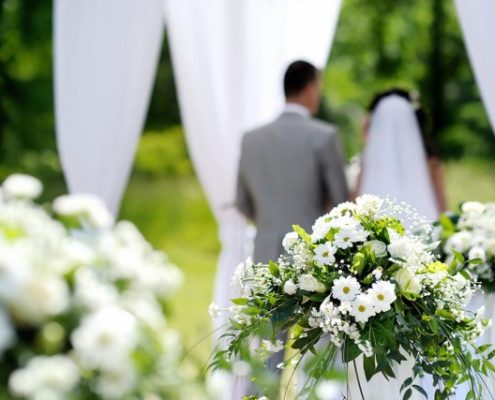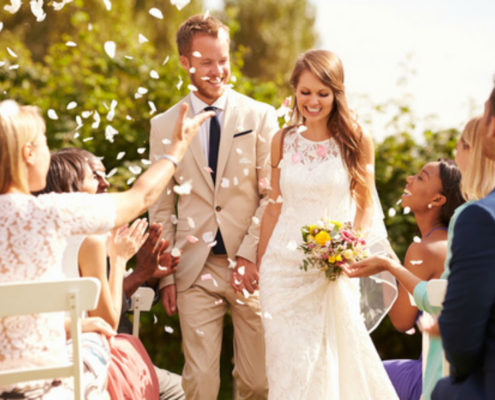English Weddings
Pre-Wedding ceremony and traditions
Marriage is usually initiated by a proposal of marriage between the two people. This traditionally involves the presentation of a ring (an engagement ring) and the formalized asking of a question such as “Will you marry me?” The person proposing may even go down on one knee to ask the question. If the proposal is accepted, the couple become engaged. This is symbolized by the coupling wearing a engagement ring on left hand.
Traditionally men are supposed to propose to women, however in the UK the 29th of February (in a leap year) is said to be the one day (coming around only once every four years) when a woman can propose to her partner.
Typical engagements last roughly one year to 18 months but can be shorter or longer.
Before the wedding there is a ‘Hen’ Party for the bride and her female family and friends and a ‘Stag’ party for the groom and the male members of the family/friends. These usually take place anything from a month before the wedding to a few days before.
Before the wedding day, as well as ensuring that the venue is booked, the flowers are arranged, the outfits are prepared, and all the other aspects of the wedding day are arranged.
The couple give ‘notice of marriage’ at their local register office. Couples must get married or register their civil partnership within one year of the wedding.
Invitations normally go out about 3 months before the wedding.
Wedding Day
On the morning of the wedding there is a tradition of ‘Something old, something new, something borrowed, something blue’. This tradition comes from an Old English rhyme “Something Old, Something New, Something Borrowed, Something Blue, A Sixpence in your Shoe”, and the four objects that the bride adds to her wedding outfit or carries with her on the big day are just good luck charms.
Something old represents continuity; something new offers optimism for the future; something borrowed symbolizes borrowed happiness; something blue stands for purity, love, and fidelity; and a sixpence in your shoe is a wish for good fortune and prosperity.
Best Man – a close male relative or friend, who assists the groom on the wedding day. They keep the ring safe, in charge of the ushers, acts a witness of the wedding and gives a speech.
Page boys – walk down the aisle before the bride – sometimes they carry the ring.
Flower girl – walks down the aisle and scatters flower petals before the bride.
Father of the Bride – One who symbolically “gives away” the bride. If her father is deceased or otherwise unavailable, another male relative, often an uncle or brother, will give the bride away. Father of the Bride traditionally gives a speech.
Brides wear a white wedding gown with a veil – traditionally these were worn covering the brides face and were then revealed to the groom and the guests by the bride’s father.
Within the “white wedding” tradition, a white dress and veil would not have been considered appropriate in the second or third wedding of a widow or divorcee. Nowadays it isn’t an issue.
Grooms wear 3-piece suits.
Traditionally, the side on which people sit depends on whether they are friends or family of the bride or of the groom. The front rows are generally reserved for close family or friends, with the very first seats reserved for the bridal party.
The groom and his best man wait inside the church for the arrival of the bride.
The bride is accompanied down the aisle by her father, who stands on the brides left hand side traditionally.
During the ceremony the bride and groom make their marriage vows. Marriage vows are promises a couple makes to each other during a wedding ceremony. In Western culture, these promises have traditionally included the notions of affection, faithfulness, unconditionality and permanence
After the vows have been spoken the couple exchange rings. The wedding ring is placed on the third finger of the left hand, also called the “ring” finger. The wedding ring is usually a plain gold ring.
After the wedding ceremony, the bride, groom and two witnesses generally go off to a side room to sign the wedding register. Without this the marriage is not legal and a wedding certificate cannot be issued.
Afterward, guests file out to throw flower petals, confetti over the newly-married couple for good luck.
The bride stands with her back to all the single and unmarried guests and throws her bouquet over her head to them. Whoever catches the bouquet is the next person to get married.
After the ceremony, the guests make their way to the reception which is usually held in a hotel, restaurant, or something similar.
Once all guests have arrived the bride and groom are then announced, everyone stands up and the couple make their way to their seats. They usually sit at a “top table” with the parents, best man and maid.
After the meal at the reception party there is normally speeches – usually the father of the bride welcomes his new son in law to the family, the best man will make a speech (this is usually supposed to be humorous) and then the groom will make a speech.
Everyone is given champagne (or non-alcoholic equivalent) for the speeches and they toast the couple after every speech.
The couple then cut the wedding cake which is normally a traditional fruit cake. It is considered lucky for the couple to cut the cake together. It symbolises them working together during their marriage.
Any dancing is commonly started by the bride and groom which is called the “First Dance”, often the couple chooses their favourite piece of music or a song.
From the reception party the bride then leaves with her husband to start their new life together.
Day After the Wedding
Usually after the wedding, the bride and groom will go on honeymoon and sometimes they go straight after the wedding. On arriving back home it is traditional for the husband to carry his wife into their new home. This is called carrying the bride over the threshold.



